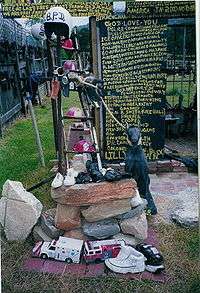Joe Minter
Joe Minter (born March 28, 1943, Birmingham, Alabama) is an American sculptor based in Birmingham, Alabama.[1][2]
Joe Minter | |
|---|---|
| Born | Joe Wade Minter Sr March 28, 1943 |
| Nationality | American |
Early life
Minter was born the eighth child into a family of ten.[3] His father was a mechanic during World War I, but after the war, was unable to find a job in his field. Minter's father instead worked for thirty years as caretaker of a white cemetery.[3] Joe Minter attended local Birmingham schools, was drafted in 1965 and discharged in 1967.[3] After the military, Minter took a series of low-paying jobs, from dishwasher at a drive-in, to messenger and orderly hospital work. Minter also worked in metals, constructed school furniture, did work on cars, and with crews building roads.[3] As a result of his fabrication work, Minter got asbestos dust in his eyes in the 1960s and ‘70s. Minter had one eye was operated upon to mediate the asbestos; however, he wouldn't let the doctors operate the other eye.[3] Minter never lost the feeling of grit in his eyes and was forced to retire. Upon retiring, Minter rediscovered an artistic practice dormant since childhood.[3]
Artistic practice
African Village in America
Located on the southwest edge of Birmingham, Alabama and begun in the late 1980s and built over the course of thirty years, Minter's African Village in America is part sculpture garden, part history museum, and part memorial.[4] The African Village in America is an ever-evolving art environment, populated by sculptures made from scrap and found materials from footwear, lawn decorations, toys, old sporting equipment, to baking utensils, and more.[5][6] Although Minter's sculpture have a variety of themes and influences, from one commemorating the Sandy Hook Elementary School shooting to one dedicated to the victims of Hurricane Katrina, Minter's overriding message is to provide a recognition for the eleven million Africans shipped in bondage to America, and to their descendants who helped to build and defend America.[3] The sculptures in the African Village in America tell the stories of African-Americans over the centuries, from the griots and warriors of West Africa to the deadly 1963 bombing at the 16th Street Baptist Church.[2]


Exhibitions
- 2019 – Whitney Biennial – Whitney Museum of American Art – curated by Rujeko Hockley and Jane Panetta[7]
- 2018 – History Refused to Die: Highlights from the Souls Grown Deep Foundation Gift - Metropolitan Museum of Art[8]
- 2018 - Revelations: Art from the African American South - de Young Museum, San Francisco, CA[9]
- 2018 - Joe Minter: Once That River Starts to Flow - Atlanta Contemporary, Atlanta, Georgia[10]
- 2017 - The Road Less Traveled Exhibition Series. American Sites: Art Environment Photography - The John Michael Kholer Arts Center, Sheboygan, WI[11]
- 2015 - History Refused to Die - Alabama Contemporary Art Center, Mobile, AL[12]
- 2014 - When Stars Begin to Fall: Imagination and the American South - Studio Museum in Harlem, New York[13]
- 2007 - Alabama Folk Art - Birmingham Museum of Art, Birmingham, Alabama[14]
- 2004 - Coming Home: Self-Taught Artists, the Bible, and the American South - Art Museum of the University of Memphis, Memphis, TN[15]
Permanent collections
- Metropolitan Museum of Art, New York, NY[6]
- Smithsonian American Art Museum, Washington, D.C.[4]
- Fine Arts Museums of San Francisco, San Francisco, CA[16]
- High Museum of Art, Atlanta, GA[17]
- Birmingham Museum of Art, Birmingham, AL[18]
Publications
- Finley, Cheryl; Griffey, Randall R.; Peck, Amelia; Pinckney, Darry. My Soul Has Grown Deep: Black Art from the American South. Metropolitan Museum of Art, 2018[19]
- Anglin Burgard, Timothy (Editor), Thornton Dial (Contributor), Lonnie Holley (Contributor), Joe Minter (Contributor), Lauren Palmor (Contributor). Revelations: Art from the African American South. Prestel, 2017[20]
- Horace Randall Williams (Author), Karen Wilkin (Author), Sharon Holland (Author), William S. Arnett (Introduction), Bernard Herman (Contributor). History Refused to Die: The Enduring Legacy of African American Art in Alabama. Tinwood Books, 2015[21]
- Crown, Carol, ed. Coming Home: Self-Taught Artists, the Bible, and the American South, Jackson, MS: University Press of Mississippi, 2004[15]
- Conwill, Kinshasha; Danto, Arthur C.;Testimony: Vernacular Art of the African-American South. Harry N. Abrams, 2002[22]
- Arnett, William and Paul Arnett, eds. Souls Grown Deep: African American Vernacular Art of the South, vol. II, Atlanta: Tinwood Books, 2001[23]
References
- "1943 – JOE MINTER". Souls Grown Deep.
- Tortorello, Michael (April 24, 2013). "Joe Minter's African Village in America". The New York Times. ISSN 0362-4331. Retrieved March 21, 2019.
- Hernández, Jo Farb. "Joe Minter, African Village in America | SPACES". spacesarchives.org.
- "The Dreamer". Smithsonian American Art Museum. Retrieved March 21, 2019.
- "African Village in America". Atlas Obscura.
- Minter, Joe. "Four Hundred Years of Free Labor, 1995". metmuseum.org.
- "Whitney Biennial 2019". whitney.org.
- "History Refused to Die". metmuseum.org. Retrieved March 21, 2019.
- "Revelations: Art from the African American South". de Young. August 4, 2017. Retrieved September 12, 2019.
- Studio, Familiar. "Joe Minter". Atlanta Contemporary. Retrieved September 12, 2019.
- "John Michael Kholer Arts Center Exhibition The Road Less Traveled". John Michael Kholer Arts Center. Retrieved 9/12/2019. Check date values in:
|access-date=(help) - "Tom Leeser Creates Video Installation for Joe Minters African Village in America". Retrieved 9/12/2019. Check date values in:
|access-date=(help) - "When the Stars Begin to Fall". The Studio Museum in Harlem. September 11, 2017. Retrieved September 12, 2019.
- "Joe Minter - Artists - Outsider Art Fair". www.outsiderartfair.com. Retrieved September 12, 2019.
- Coming home! : self-taught artists, the Bible, and the American South. Crown, Carol., Doss, Erika, 1956-, University of Memphis. Art Museum., Florida State University Museum of Fine Arts., American Bible Society. Gallery. [Memphis]: Art Museum of the University of Memphis. 2004. ISBN 1578066581. OCLC 53896594.CS1 maint: others (link)
- "Fine Arts Museums of San Francisco Make Historic Acquisition of 62 Works of African American Art from the Souls Grown Deep Foundation". de Young. February 2, 2017. Retrieved March 21, 2019.
- "Chains In Paradise". High Museum of Art. Retrieved September 12, 2019.
- "'63 Foot Soldiers | Birmingham Museum of Art". www.artsbma.org. Retrieved September 12, 2019.
- My soul has grown deep : Black art from the American South. Finley, Cheryl,, Griffey, Randall R.,, Peck, Amelia,, Pinckney, Darryl, 1953-, Metropolitan Museum of Art (New York, N.Y.). New York. May 21, 2018. ISBN 9781588396099. OCLC 1022075437.CS1 maint: others (link)
- Burgard, Timothy Anglin (2017). Revelations : art from the African American South. Dial, Thornton,, Pitkin, Stephen,, M.H. de Young Memorial Museum. San Francisco, CA. ISBN 9783791357171. OCLC 982465355.
- History refused to die : the enduring legacy of the African American art of Alabama. Arnett, William S.,, Bickford, Laura (Editor),, Montgomery Museum of Fine Arts,, Alabama Contemporary Art Center,, Printed by the Prolific Group. [Montgomery, Ala.] 2015. ISBN 9780692365205. OCLC 909397263.CS1 maint: others (link)
- Testimony : vernacular art of the African-American south : the Ronald and June Shelp collection. Conwill, Kinshasha., Kalamazoo Institute of Arts. New York: H.N. Abrams in association with Exhibitions International and the Schomburg Center for Research in Black Culture. 2001. ISBN 0810944847. OCLC 46366258.CS1 maint: others (link)
- Souls grown deep : African American vernacular art of the South. Arnett, Paul., Arnett, William. (1st ed.). Atlanta, Ga.: Tinwood Books. ©2000-. ISBN 0965376605. OCLC 44496372. Check date values in:
|date=(help)CS1 maint: others (link)